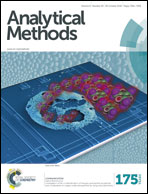A novel label-free electrochemical immunosensor for the detection of hepatitis B surface antigen†
Abstract
A novel label-free electrochemical immunosensor based on trimetallic NiAuPt nanoparticles on reduced graphene oxide nanosheets (NiAuPt–NGs) was developed for the quantitative detection of hepatitis B surface antigen (HBsAg). Due to the synergetic effect present in the trimetallic NiAuPt–NG nanocomposite, the NiAuPt–NG nanocomposite shows better electrocatalytic activity towards the reduction of hydrogen peroxide (H2O2), which is much better than that of monometallic Pt–NG, bimetallic NiPt–NG and AuPt–NG nanocomposites. In this work, the NiAuPt–NG nanocomposite with a large specific surface area, good biocompatibility and excellent electrical conductivity was used to capture antibodies efficiently and amplify the signal of the proposed immunosensor. The amperometric i–t technique was used to record the changes of electrochemical signals when electrodes were modified with different concentrations of HBsAg. Under the optimal conditions, the proposed electrochemical label-free immunosensor exhibits excellent analytical performance for the measurement of HBsAg with the linear range from 0.001 to 80 ng mL−1 and a detection limit of 0.31 pg mL−1, which may have promising application in bioassay and enrich the electrochemical immunoassays.


 Please wait while we load your content...
Please wait while we load your content...